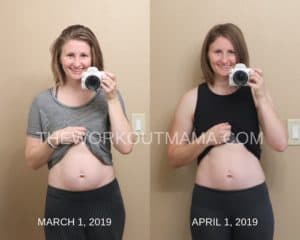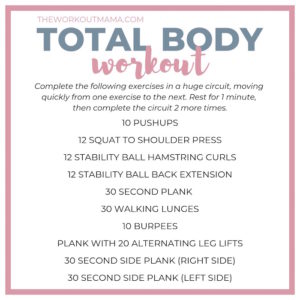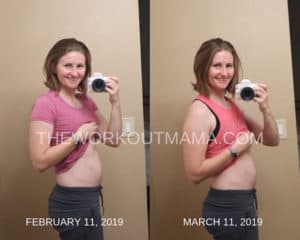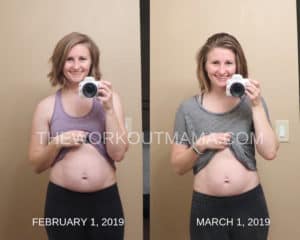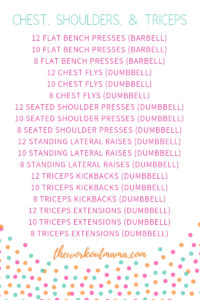I am not sure how it is April already, this year is flying by. I wanted to do a quick update on how I am plugging along with my fitness and wellness journey in 2019. March came and went and I am happy to report that I am down another 4 pounds! I am beyond thrilled. In total I have lost 10 pounds since February! If you are just joining the conversation I gained 15 pounds in 2018 and was determined to get back on track with my eating and finding more consistency with my workouts. You can read about that and see pictures HERE. Eating I am still not eating eggs or drinking caffeinated drinks, but have been a bit more lax on the sugar ;). I am not wanting to be restrictive with my eating and think it is totally appropriate and necessary to have a few treats here and there. Mid month I also started tracking my macro's because I was curious how much food I was actually eating. I discovered I was not eating enough carbohydrates during the day and was overeating fat and … [Read more...]
30 Minute Total Body Workout
It has been forever since I actually shared a workout. I hope to start sharing more workouts on here and to update the workout page with previous workouts I have posted. I have been exercising about 4-6 days a week consistently since February and it feels amazing. We don't have a gym membership so I am getting up in the morning before everyone in the house is awake and exercising at home. Over the years we have accumulated a nice variety of workout equipment for at home use. For this workout you will need a stability ball and a set of dumbbells. I used 15 pounds for the squat to shoulder press and the walking lunges but you can go lighter or heavier if needed. This is a quick circuit style workout that will have you sweating and leave you feeling accomplished when you have finished. Move from one exercise to the next. Once you have finished rest for 1 minute and repeat for 2 more rounds. It should take you around 30 minutes to finish. These are my favorite type of … [Read more...]
The Fitnessista’s Home Workout Warrior Live Fit Guide Review
Back in early February I was reading Gina's blog and saw she was offering 1 month of her Home Workout Warrior program for $9. The program normally costs $97 for 12 weeks so it was an easy decision to purchase. It was a great way for me to try something I had been interested in without the larger financial investment. I am so glad I did! It can be nerve-wracking sometimes to purchase something without having a solid idea what you are buying. The Fit Guide comes with workouts, a meal plan, as well as suggested options for cardio. So if you have been on the fence about this program here is my review. The Workouts I really loved the way the workouts were organized. I never got bored and I felt challenged at just the right amount. Each week there were specific Upper Body, Core, Lower Body, Total Body, HIIT (High Intensity Interval Training), and Cardio workouts. I was able to complete most of the workouts in 30 minutes. This was great because I woke up in the morning … [Read more...]
What Happened When I Eliminated Eggs, Sugar, & Caffeine For 28 Days
This post could have easily been titled "I Gained 15 Pounds in 2018" because I did. Towards the end of 2018 between numerous bought of sickness that spread like wildfire throughout our home and the ridiculous amounts of baking I did over the holidays I discovered I had gained 15 pounds after ringing in the New Year. I was actually fairly surprised because I didn't really feel heavier. I honestly hadn't even been paying attention to how I looked in the mirror. When you have 4 kids time management becomes very important. I could probably win a gold medal at this point for how fast I can go to the bathroom, change a diaper, and get myself and all the kids dressed ;). In February I knew I wanted to overhaul how I was fueling my body and also commit to exercise more consistently each week. So here is what I started doing. WHAT I ELIMINATED FROM MY DIET I eliminated 3 main things from my diet that I knew weren't helping me. Eggs. Added Sugar. Caffeine. Eggs I had been … [Read more...]
3 Day Split Workout
Building muscle mass and gaining strength are fantastic goals to have. It can sometimes be challenging to know how to begin to program a routine that will yield these results. I have you covered with my 3 day split workout program that can be done at the gym or at home. You will need moderate to heavy dumbbells that you are able to lift for multiple sets of 8-12 reps. If you have access to a barbell that will be super helpful but you can always substitute with dumbbells if needed. BENEFITS OF A 3 DAY SPLIT WORKOUT A spilt workout is a strength training method where you train different muscle groups on different days of the week. This method allows you to spend more time on each muscle group and train with more intensity than a total body workout, plus it also allows your muscles more time to recover. 3 day spilt workouts are easy to follow and are the perfect fit if you are having a hard time making it to the gym or even to squeeze a workout in at home. These workouts will challenge … [Read more...]
Movie Workout: The Greatest Showman
Josh and I watched The Greatest Showman several months ago for the first time and it quickly became a family favorite. It also became the new soundtrack for our family dance parties that happen daily. This movie just makes me happy when I watch it. The dancing, the singing, and costumes are all amazing. Our oldest is dressing up as PT Barnum for Halloween this year and I am in the process of sewing his coat. Wish me luck. This soundtrack has been on repeat in our house for the last few months. I have shared only one other movie workout on the blog it was for Frozen. So it has been awhile since anything like this has been posted. You can do the workout while you are watching the movie or you can do it listening to the soundtrack. The soundtrack version of this workout is tough because there is no rest and you are working for 39 minutes straight. For the entire duration of each song you will either rotate between two exercises or do a single exercise. Disclaimer: Not all … [Read more...]




